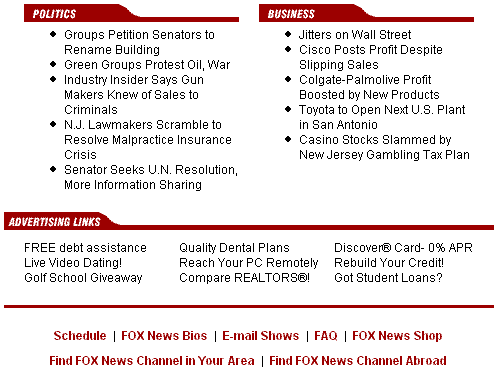From the Society of Professional Journalists' Code of Ethics:
Journalists should distinguish news from advertising and shun hybrids that blur the lines between the two.
Ah, that stern creed we all learned in J-school. "Label advertising accordingly," we were taught. "It'll keep us credible."
It did, for the most part, for many years. Then the digital age came, and some news outlets stayed ethical, and others sold out, and others just kinda did both, depending on the weather.
But, mostly, online news sites did an OK job of labeling advertising. Now, though, there's an emerging problem with the way this is done: News sites are not taking into account non-graphical browsers and the ramifications of relying on graphics alone to distinguish advertising content.
An example: FOXNews.com displays a section of advertising links toward the bottom of its home page. Here's what that looks like in a modern graphical browser. (I've included the parts of the page immediately before and after the ads, to give context.)

The ad section's strong graphical resemblance to the other (news) sections is ethically questionable -- and flies in the face of the established convention that advertising should appear in a different design/typeface -- but that's not the problem I'd like to point out here.
The problem I'd like to point out here becomes obvious when you view this page in an unconventional browser. Here's a screenshot of the same section of FOXNews.com, as viewed in Microsoft Mobile Explorer Emulator, which "simulate[s] the activity of using a browser on a mobile phone"
, according to its documentation:

There's little to distinguish those advertising links from the genuine news links. Yes, astute readers will correctly suspect "FREE debt assistance" is advertising, but what of "Quality Dental Plans"? What of "Got Student Loans?"? The former could very well be the headline of a story in the health section; the latter sounds like a fluffy feature headline. An unsuspecting reader might see it, follow the link and be surprised (and irritated) when he or she realizes it's an ad. Or, worse yet, a reader might read the subsequent advertising content indiscriminately, believing Fox News -- not a paid advertiser -- was providing that information as a fair and accurate news outlet.
And let's look, now, at how Lynx, a text-only browser, interprets this page:
* Groups Petition Senators to Rename Building * Green Groups Protest Oil, War * Industry Insider Says Gun Makers Knew of Sales to Criminals * N.J. Lawmakers Scramble to Resolve Malpractice Insurance Crisis * Senator Seeks U.N. Resolution, More Information Sharing * Jitters on Wall Street * Cisco Posts Profit Despite Slipping Sales * Colgate-Palmolive Profit Boosted by New Products * Toyota to Open Next U.S. Plant in San Antonio * Casino Stocks Slammed by New Jersey Gambling Tax Plan [INLINE] [INLINE] [INLINE] [INLINE] [INLINE] [INLINE] [INLINE] [INLINE] [INLINE] FREE debt assistance Live Video Dating! Golf School Giveaway Quality Dental Plans Reach Your PC Remotely Compare REALTORS! Discover Card- 0% APR Rebuild Your Credit! Got Student Loans? [INLINE] [INLINE] [INLINE] Schedule | FOX News Bios | E-mail Shows | FAQ | FOX News Shop [INLINE] Find FOX News Channel in Your Area | Find FOX News Channel Abroad
Here, again, we see no difference between the news links and the advertising links.
Comments
Posted by Matt Pusey on February 5, 2003, at 11:19 p.m.:
Slashdot is guilty of this as well - look at the "Related Links" bit on any /. story, the top link is an advert, but the rest aren't.
Posted by Jay Small on February 6, 2003, at 6:16 a.m.:
You're right, still way too many examples of this out there. For a Lynx-type browser, seems to me simple alt="" attributes on those image headers would take care of it.
On wireless, though, that wouldn't always do the trick. I have a fairly new Motorola cell phone with a color screen that does, indeed, come very close to the effect you show from the emulator.
The phone can display the graphics, so it isn't trying to display an alt="" attribute -- thus, just providing an alt doesn't clear this up universally.
Posted by Joe Clark on February 6, 2003, at 6:31 p.m.:
Full advice consistent with Holovaty's can be found in my book, in fact, where I was totally hardcore about labeling every advertisement as such.
Posted by Nathan Ashby-Kuhlman on February 6, 2003, at 10:16 p.m.:
A point of clarification for you, Adrian -- when you say "all browsers" should display labels for advertising, do you mean just "all modern browsers" (whether graphical, mobile, screen readers, etc.) or do you literally mean "all browsers"? It may be a losing battle to try to get the labels displayed in, say, Netscape 2 while simultaneously making sure they appear in modern browsers.
Posted by Adrian on February 8, 2003, at 12:45 a.m.:
I'll second Mr. Joe Clark's statement. His book does indeed touch on this topic. The book is outstanding, and one of these days I'll post a review here.
Nathan: Yup, I meant "all browsers." Aren't the rendering capabilities of Netscape 2 equatable to those of mobile browsers, anyway? Both offer archaic support of advanced HTML.